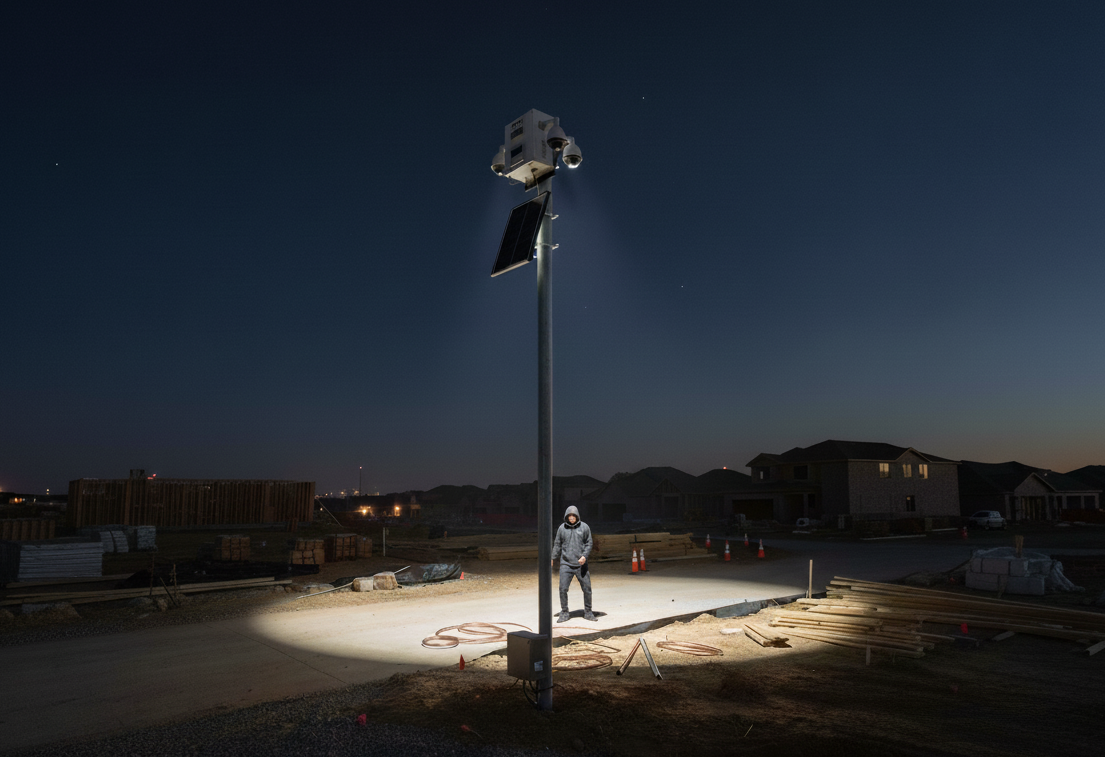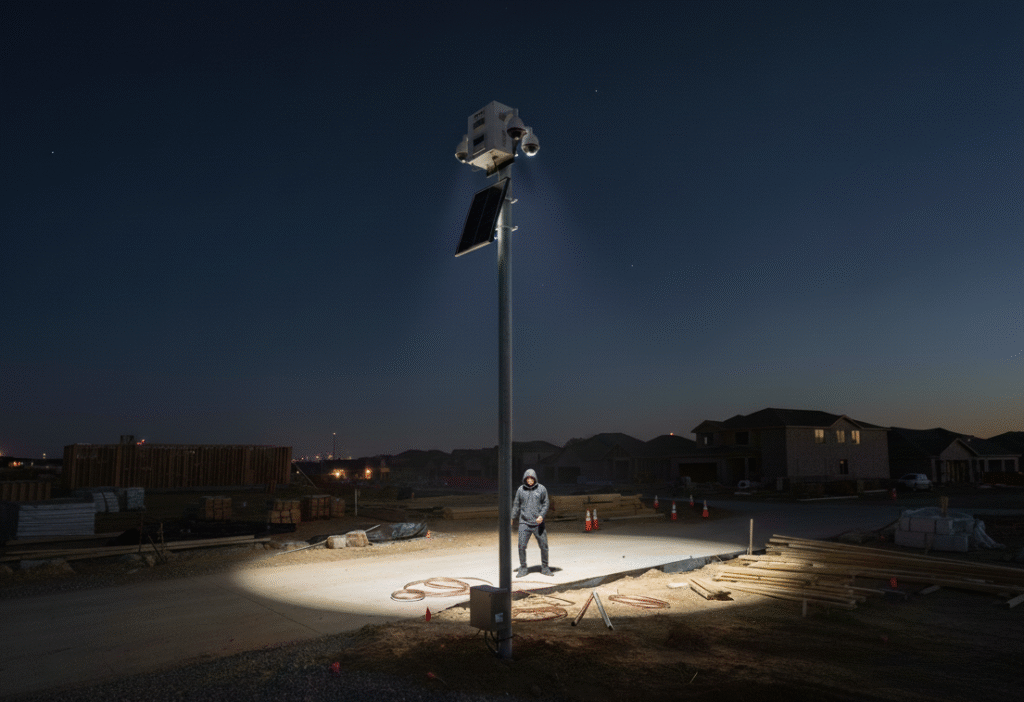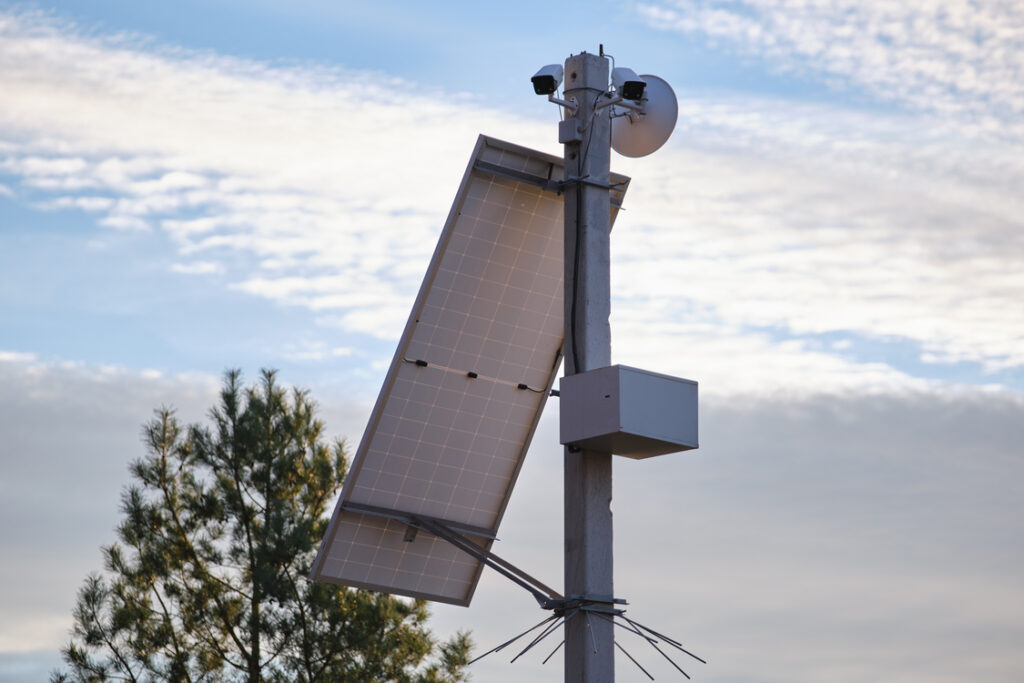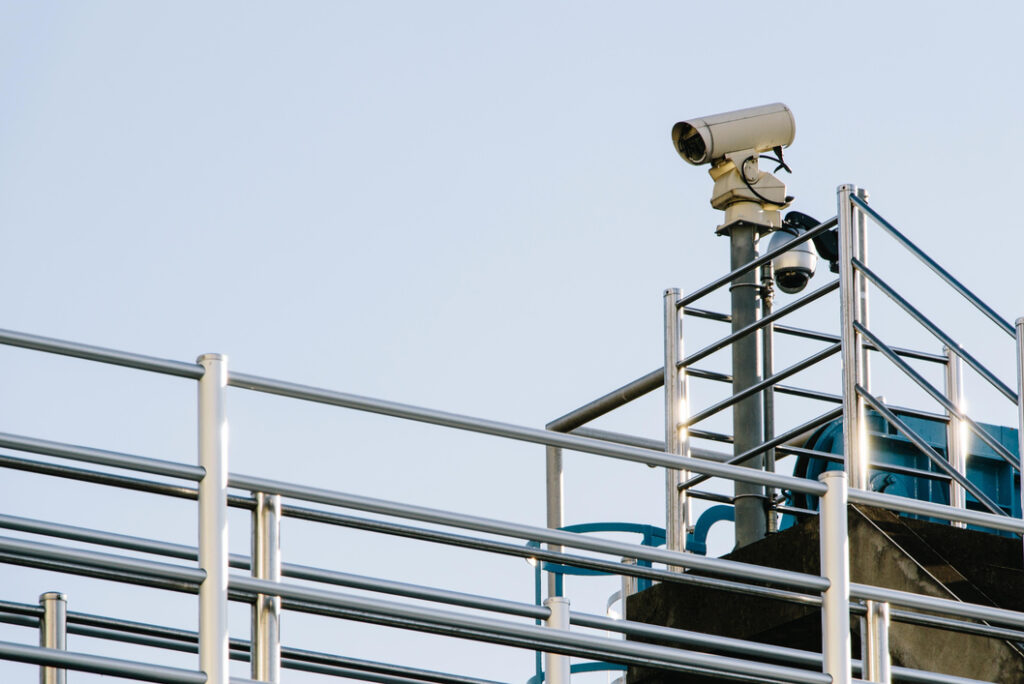Construction sites are high-value, low-guarded targets. Visible, actively-monitored cameras paired with lighting, strobes, sirens, and live talk-down speakers raise the perceived risk for offenders and cut losses.
This guide shows how to design a deterrence-first camera layout for temporary and mobile jobsites, with practical steps you can implement this week.
Why Deterrence Matters (and What the Data Says)
Construction theft is persistent and costly. Industry and insurance analyses have long estimated potential $1B in annual equipment losses with a less than 25% recovery rate.
Visible surveillance helps. Large-scale reviews of CCTV show a significant but modest reduction in crime overall, with the strongest effects in places where property crimes are common (e.g., parking areas) and where systems are clearly visible and actively used. That’s the exact pattern we want on a jobsite.
Lighting is part of the deterrence package. In a randomized controlled trial in New York City public-housing developments, temporary lighting led to an estimated ~36% reduction in nighttime outdoor index crimes—evidence that brighter, more visible spaces raise offenders’ perceived risk. On jobsites, your camera floodlights and strobes play a similar role.
Mobile towers & trailers aren’t just for show. Strategically placed camera systems can stop trespassers, vandals, and thieves before they step foot on your site. Losses and delays due to criminal activity are on the rise, and technology can help curb this trend.
Finally, there’s often an insurance angle: risk experts note that verified monitoring can reduce losses and support claims. Some carriers may offer credits or discounts when proactive measures are in place (requirements vary by carrier and policy).
How Visible Systems Change Offender Calculus
Deterrence isn’t magic; it’s math in an offender’s head:
- They see cameras, lights, and signage — risk of detection goes up.
- Analytics trigger strobes/sirens — risk of interruption goes up.
- Live talk-down warns they’re recorded and police are being called — risk of consequences goes up.
That three-step flow is why visible, interactive systems outperform “record-only” setups.
A Practical Deterrence Blueprint for Construction Sites
1) Make the System Unmissable
- Placement: Mount primary deterrence cameras (with integrated white light / strobes) at vehicle gates, pedestrian entries, material laydown, fuel/storage, and PTZ overview positions.
- Height: 14–25 ft for wide deterrence visibility (and to resist tampering), with one high-vantage PTZ (25–35 ft) for site-wide sweeps.
- Signage: Post “24/7 VIDEO & AUDIO MONITORING” at entries, along fencing, and near high-value areas.
- Lighting: Use camera-linked floods and/or strobes after hours. Continuous light isn’t always necessary; analytics-triggered light is a strong behavioral interrupter (and friendly to neighbors). The deterrent role of lighting is supported by the NYC RCT noted above.
2) Use Analytics to Reduce Noise and Aim Your Deterrence
- Enable human/vehicle detection and cross-line rules on approaches and fence lines; suppress wind-moved tarps/foliage.
- Create after-hours schedules by trade and phase: the “hot zones” move as your site evolves.
- Tune dwell-time alerts (e.g., someone lingering near copper reels).
3) Plan the Audio Path (Talk-Down + Siren)
- Pair cameras with outdoor-rated speakers (and, where appropriate, sirens). Deliver clear, site-specific warnings such as:
“You are on a monitored construction site. Leave immediately. Police are en route.” - Keep sirens simple: you don’t need deafening output; you need attention and compliance without creating a nuisance.
Industry norms often cite ≥85 dB for alarm audibility, but outdoor siren choices range much higher—be mindful of neighbors and local ordinances. - Document your escalation script: light → notify → siren → voice → dispatch.
4) Choose the Right Temporary Platform
- Mobile tower/trailer: For large or power-poor sites (solar + battery; mast-mounted PTZ + fixed cams; integrated speakers/strobes; LTE/Starlink backhaul).
- Pole-mount “vault”: For smaller perimeters or long-stay projects where a compact solar kit fits better.
- Hybrid: One tower + a few rapid-deploy poles to cover blind corners.
Research and case experience show that conspicuous mobile units can reduce theft, especially when monitored (Springer).
5) Don’t Forget Site Planning Basics Around the Cameras
- Keep sightlines clean (trim vegetation; stage pallets away from fences to remove climbing aids; park vehicles to avoid obstructing lines of sight).
- Territorial reinforcement: Clear boundaries, good maintenance, and lighting all reinforce that a site is actively controlled and watched.




